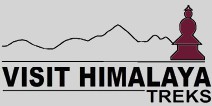Gain climbing experience in the Nepal Himalayas by attempting Mera Peak, which stands at 6,476 meters, one of the most popular trekking peaks in Nepal.
Mera Peak Climbing is a well-known trekking peak located in Nepal It has three pinnacles namely Mera Central, Mera North, and Mera South. The Pinnacles are reckoned as being the highest official Trekking Peaks In Nepal. The Prerequisite that is considered essential for Mera Peak Climbing in Nepal is to be physically fit and have a gregarious person’s sense of adventure. This simply means that Mera Peak is certainly the best place to be if you’ve always been a sporty person throughout your life.
Mera Peak Climbing and Trek highlights:-
- Exciting mountain flight to Lukla. (Tenzing Hillary airstrip).
- Trekking to the less-visited Hinku valley through the traditional Sherpa village.
- Climb the Highest trekking Peak in Nepal, with an elevation of 6476 meters, Mera Peak.
- Views 14 of 5, eight thousand peaks from Mera Peak Summit, Mount Cho Oyu, Mount Everest, Lhotse, Makalu, and Kanchenjunga.
Mera Peak's first ascent was made on May 20, 1953, by Col. Jimmy Roberts and Sen Tenzing. From the top of the peak (with good weather), 5 of the 8000-meter mountains of the world, i.e., Everest (8848 meters), Kangchenjunga (8586 meters), Lhotse (8516 meters), Makalu (8463 meters), and Cho Oyo (8201 meters) can be seen. By its standard route from the Mera La (5415 meters), the ascent is technically straightforward; however, if the mazes of crevasses open due to heavy snowfall, it can become challenging.
The most rewarding aspect of a trip to Mera is the chance to venture into a little-visited and unspoiled region of Nepal where the hillsides are still covered with dense forest. There is also, of course, the pleasure of going 6000 meters above sea level. We spend a great deal of time on acclimatization. Furthermore, we help to build your basic mountaineering skills by doing a small practice session on the glacier on acclimatization day before moving on to the high camp.
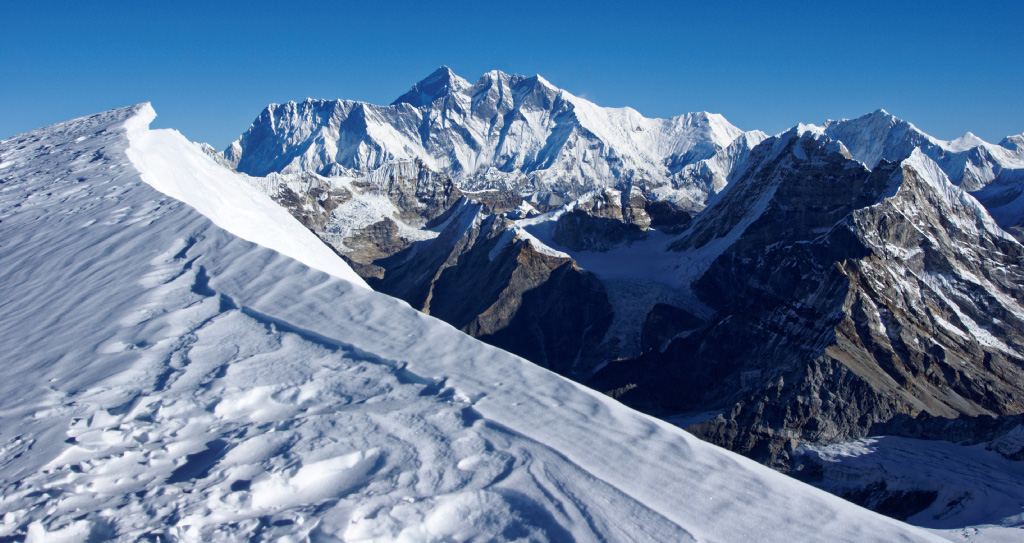
Mount Everest, Nuptse Face, and Lhotse View from Mera Peak Summit.
The Mera Peak Climbing and Trekking route,
Our Mera Peak climbing journey starts with taking a breathtaking mountain flight to the Lukla elevation of 2840m from the Capital City of Kathmandu. In Lukla, we meet our trekking support crews. We design the Mera Peak trip itinerary very carefully to avoid a quick altitude gain trek through the lower valley of the Dudh Kosi River. This route involves trekking in such a remote and beautiful Hinku valley that leads us through the rhododendrons and bamboo forest.
This is one of the most fantastic wilderness trekking experiences you will have; later we will join to Tangnag High route of the Mera Peak trail and on the way back follow the regular Mera Peak trekking route over Zatrwa La 4610 meters pass. Mera Peak is 6476 meters, as recorded as a Trekking peak. Mera Peak holds three summits: Mera Peak 6476 meters, Mera Central 6461 meters, and Mera South 6065 meters.
As a universal mountaineering principle, to acclimate well in higher altitudes, it is highly recommended that you make a gradual ascent to the apex of the mountain. We at Visit Himalaya put the safety and well-being of our clients as our utmost priority. The conventional route to Mera Peak: Lukla (2860m)- Chutenga (3350m)-Zatrwa La Pass 4610 meters - Chatrarbu (4340m)-Thagnak (4356m) ascends very steeply to higher altitudes.
Our decades of experience in the industry have led us to believe that this route exposes climbers to extreme risks of High-Altitude Sickness, and we have chosen the most favorable route for the Mera Peak Climb. Our route for Mera Peak Climb is Lukla(2860m)- Chutok (2730m)- Pangkogma(2846m)- Nashing Dingma(2600m)- Chalem Kharka(3600m)- Khola Kharka(4200m)-Thagnak(4356m)- Mera Base Camp (5300m)- Mera High Camp (5780m)- Mera Peak (6461m), Our itinerary defines it clearly.
How difficult to climb Mera Peak?
Mera Peak Climbing trip is an ambitious (challenging) trip that combines trekking and Climbing. Therefore, you should be very well trained and have some experience with mountaineering at high altitudes. Trekking requires a performance above the average relating to force and endurance. Especially the summit day will be long and exhausting. Concerning the technical alpine skills, you should have security in your steps and be free from giddiness. Even in bad weather, you should be able to walk safely on your own through difficult terrain like screes, rocks, and as well as on flat glaciers. Security in your steps means walking on exposed trails where a fall has fatal consequences. As you will sleep a few nights above the altitude of 4000 meters up to 5800 meters, very good health is required.
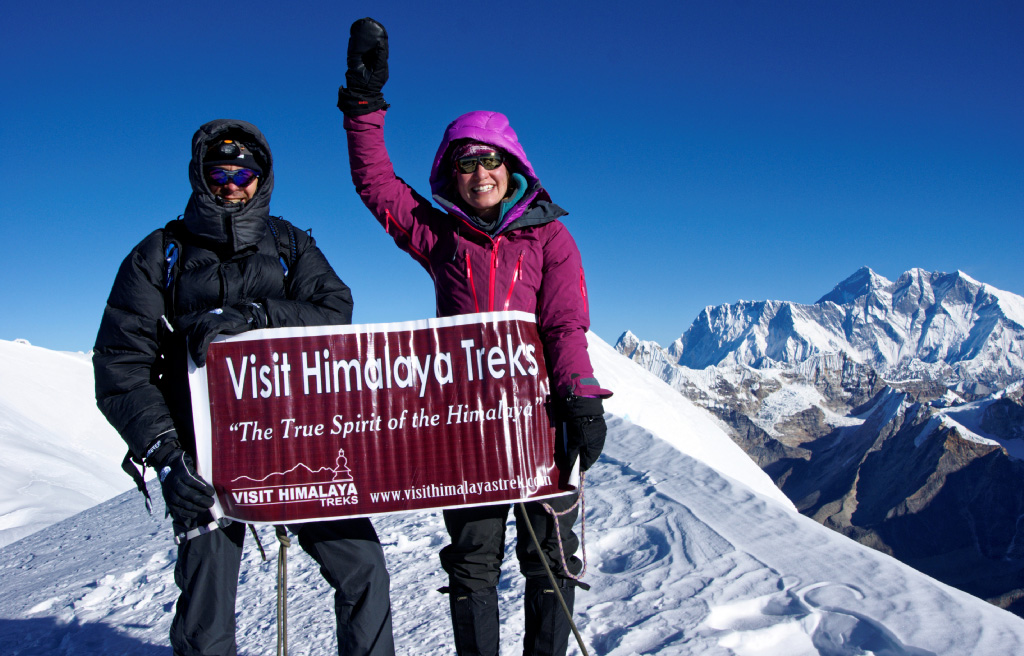
Mera Peak Summit Background Mount Everest View.
Accommodation availability for Mera Peak Climbing and Trekking.
Nowadays, you may trek and climb Mera Peak by staying at a basic tea house along the route of Mera Peak minimum of 5 to 6 people in a group. If you are in a large group, then you will need full camping gear with the camping supporters’ team because basic tea houses/ lodges have not had enough capacity for accommodation along the route of Mera Peak for the large group.
When is the best time to climb and Trek to Mera Peak?
The Best Time to climb and Trek to Mera Peak, like any other peak in Nepal, is suitable to climb during two seasons: Autumn (September-November) and Spring (March-May). The different weather patterns in Nepal are extreme, which causes climatic anomalies all across the national boundary, making it difficult for climbers to summit the peak. The Monsoon (June-August) brings in heavy clouds from the eastern Bay of Bengal, which pour out heavy rain across the nation. On the other end, during the winter (December- February), there are heavy snowfalls in the Himalayan belt, making it impossible for climbers to make it to the summit.
Can a beginner climb Mera Peak?
Having been classified as a trekking peak, Mera Peak is not much of a technical mountain. It is a pretty straightforward mountain with little to not much of steep climb. Aside from a few crevasses along the glacial path, Mera Peak is considered the perfect peak for beginner climbers. Owing to this very fact, Novice climbers opt for Mera Peak as their first mountain before embarking on bigger mountains above 6500 meters.
That being said, a good knowledge of all gears and their operation is paramount for summiting. You will be provided with the best mountain guides by our team at Visit Himalaya for a comfortable and safe climbing operation.
Is Mera Peak a trekking peak?
Nepal Mountaineering Association (NMA), the governing body of mountaineering activities in Nepal, has enlisted a total of 27 mountains as trekking peaks. The mountains that range from an elevation of 5800 meters up to 6500 meters are considered trekking peaks in Nepal. On that note, Mera Peak reaches an elevation of 6476 meters. Hence, Mera Peak is a trekking peak and the highest among the 27 trekking peaks that are located in Nepal.
Can you climb Mera Peak without a guide?
No, you cannot climb Mera Peak without a guide. The Nepal Government mandates that every peak summit must be accompanied by a professional government-registered mountain guide. Furthermore, to climb any peaks in Nepal, one must have to apply for a permit through a registered expedition company.
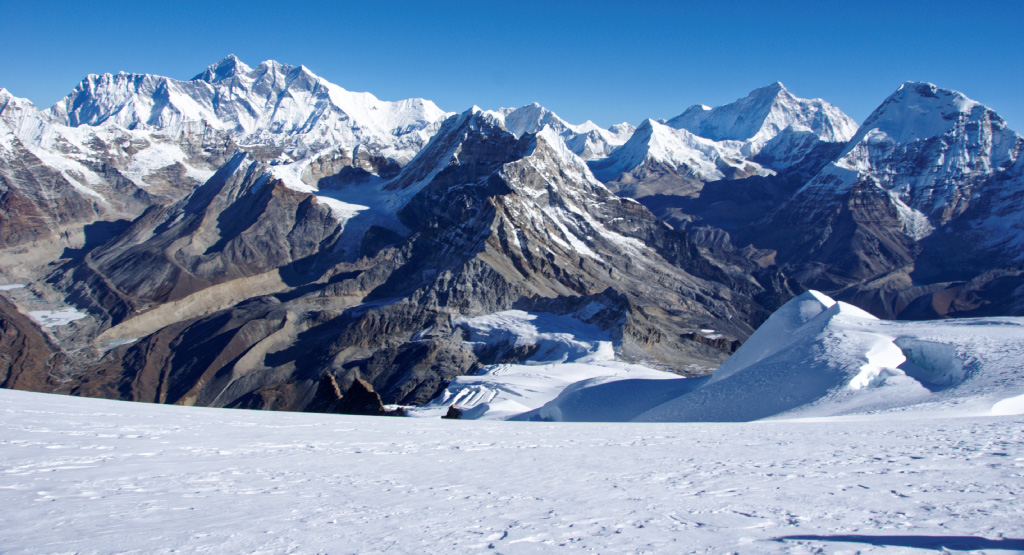
Mount Everest and Mount Makalu View from Mera Peak Climbing Trip.
Can you climb Mera Peak solo?
The Nepal Government has made it compulsory for any foreigners who want to climb any peak in Nepal to have a government-registered mountain guide to accompany them during the climb. Hence, no, you cannot climb Mera Peak solo. Our team at Visit Himalaya has been organizing and successfully summiting Mera and other countless peaks for decades. Our guides are professionally trained and are registered by the Nepal Government.
Lukla Flight Information.
Kathmandu Airport and the runways are shared by both domestic and international flights. It can be quite busy in the high tourism seasons, when Lukla flights will be at their peak. To avoid the busy air traffic and landing on the runways can be a problem.
Completing the flights and making sure all travelers are in Lukla and Outing from Lukla on time. The Lukla Flight operates from Manthali (Ramechhap) Airport during the peak season. The months of October and November are in the autumn season, and the months of March to May are in the Spring season Lukla flights operate from Manthali (Ramechhap Airport).
During this period (October and November in the autumn season and March to May in the Spring season), there is no flight available from KTM – LUKLA and from LUKLA – KTM.
During peak tourism season, October and November in the Autumn season and March to May in the Spring season, Lukla flights operate only from Manthali (Ramechhap Airport).
Scenic Flight to Lukla Airport Full Information read here.
Mera Peak Climbing Itinerary:-
Day 01: Arrive in Kathmandu, where you will be greeted at the airport and transferred to the KTM Hotel for an overnight stay.
Day 02: Sightseeing & Trek Preparation, obtaining permits, and attending a briefing. We will stay overnight at the KTM Hotel.
Day 03: Fly from Kathmandu (1350m) to Lukla (2840m), and then trek to Paiya (2730m). Alternatively, drive to Ramechhap for about 4.5 hours, fly to Lukla, trek to Paiya, and stay overnight at a tea house/lodge.
Day 04:Trek from Paiya (2730m) to Pangom (2846m) takes about 5 hours. Stay overnight at the Tea House / Lodge.
Day 05:Trek from Pangoma (2,846m) to Nagindingma (2,650m) for about 6 hours and stay overnight at a tea house/lodge.
Day 06:Trek from Nagindingma (2,650m) to Khola Kharka (3,930m) takes about 6 hours, with an overnight stay at a tea house/lodge.
Day 07:Trek from Khola Kharka (3,930m) to Kothe (3,691m) takes about 7 hours, and we will stay overnight at a tea house/lodge.
Day 08:Trek from Kothe (3,691m) to Thaknak (4,358m) for about five hours, staying overnight at a tea house/lodge.
Day 09: Acclimatization or rest day in Thaknak (4,358m). This is a preparation and acclimatization day at Thaknak, and you will stay overnight at a tea house/lodge.
Day 10:Trek from Thaknak (4,358 m) to Khare (5,045 m) for approximately 5 hours and stay overnight at a tea house/lodge.
Day 11: Acclimatization or rest day in Khare (5045m). This is a preparation and acclimatization day at Khare, and you will stay overnight at a tea house/lodge.
Day 12: Trek from Khare (5,045m) to Mera High Camp (5,780m) takes about 6 hours, with an overnight stay at the camp.
Day 13:Ascend from High Camp (5,780m) to Mera Summit (Mera Central - 6,461m), then descend to Khare (5,045m).
Day 14: An extra day for bad weather conditions or for additional acclimatization.
Day 15:Trek from Khare (5045m) to Kothe (3600m) takes about 6 hours, and we will stay overnight at a tea house/lodge.
Day 16:Trek from Kothe (3600m) to Chetarwa (3580m) takes about 7 hours, with an overnight stay at a tea house/lodge.
Day 17:Trek from Chetarwa (3,580m) to Lukla (2,800m) takes about 7 hours, staying overnight at a tea house/lodge.
Day 18: Flight from Lukla (2800m) to Kathmandu (1350m) or (Flying from Lukla to Ramechhap and then driving to Kathmandu, where you will stay overnight at Hotek KTM.
Day 19: It is advisable to have a free day in Kathmandu, as bad weather conditions often affect domestic flights from Lukla to Kathmandu. We strongly recommend having at least one to two additional days.
Day 20: Departure, three hours before your flight, we will transfer you to the airport for your departure to your home country.
How long does it take to climb Mera Peak?
At Visit Himalaya, we offer a total of 20 days of Mera Peak Climbing, which involves 16 days of climbing and trekking, including two acclimatization days and one extra backup day. From your starting point, Lukla to the summit and back, you will cover an average of 125 km during your climbing adventure.
Is Mera Peak harder than Island Peak?
Mera and Island Peak both are nestled in the Everest region and are the most favored peaks by beginner climbers who are sharpening their climbing skills. Both of these mountains lie in the Barun Sub-section of the Mahalangur range of the Nepalese Himalayan Belt. Mera Peak is considered to be easier from a safety standpoint as the ridges as relatively broader and the climb is less steep. In contrast, Island Peak is famed for its thrill-providing ridges and obstacles, making it a bit more technical.
In terms of elevation, Mera Peak elevates to a massive 6476 meters while Island Peak measures a little lower at 6189 meters. The climbers consider Mera Peak Climbing to be pretty straightforward from a technical standpoint, while Island Peak is an arduous peak to climb, requiring good climbing skills the perfect physical condition to summit. Summit to Island Peak traverses through narrow rocky ridges, broad glacial walks, and crevasses, making it relatively more technical than Mera Peak. In a nutshell, despite being lower in elevation, Island Peak is harder than Mera Peak from a technical standpoint.
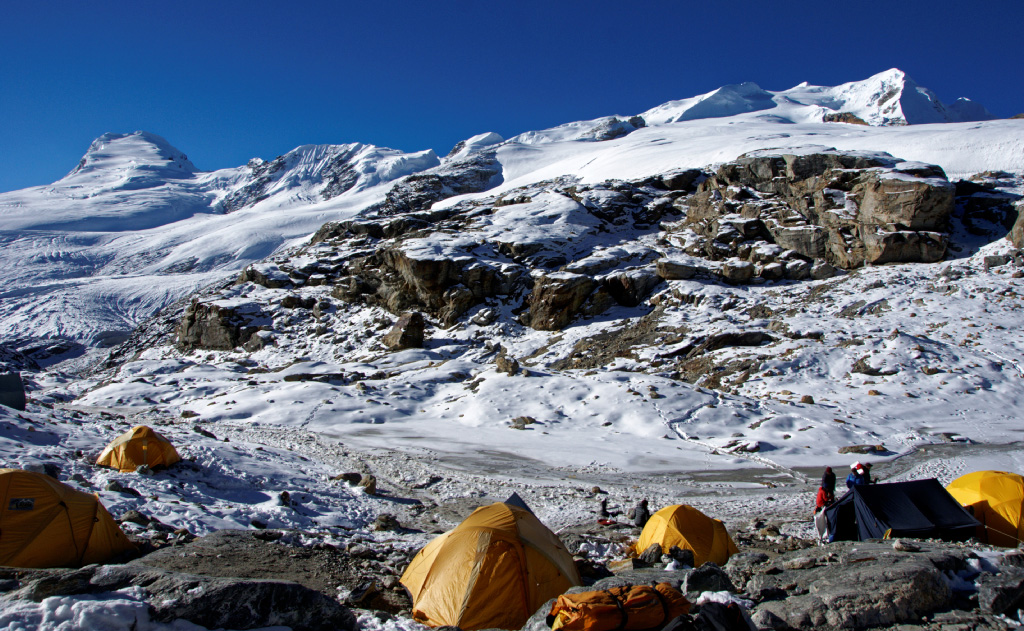
Our Campsite at Mera Peak High Camp.
How much does it cost to climb Mera Peak?
The cost varies for Mera Peak climbing varies based on multiple factors. The route you opt for and the time of the year of the climb define how much the cost will fluctuate for the Mera Peak Climbing Trip. We offer Mera Peak Climbing and Trek starting from USD 3000 for each person minimum group size of 2 people. If you are traveling with a group of friends, we offer a group discount price that we presented in the cost details section.
Mera Peak Climbing Permit cost.
As with any other mountain in Nepal, the Nepal Mountaineering Association has levied a certain cost pertaining to climbing Mera Peak. Your package cost will cover all the listed Permit charges that are required for the Mera Peak Climbing trip in Nepal.
How to Communicate during the Trek?
Most of the teahouses in the lower stretch of the Everest region will be well equipped with uninterrupted internet service and cellular networks. You can ask for the password of the Wi-Fi if it is available at your lunch stop or your overnight stop. Our team at Visit Himalaya will always be in connection with your guide to confirm everything is in place via Satellite Phone, which will always be with our Guide.
Owing to the remoteness of the region, there are several disruptions of the cellular network and power connection while climbing Mera Peak. While some teahouses may have satellite networks, they are relatively expensive and are out of service most of the time. Visit Himalaya Treks to provide satellite phone service for such a remote area where cellular networks are unavailable.
The Following personal Climbing gear list you will need to bring your own for the Mera Peak Climbing Trip in Nepal.
01: Ice Axe w/Leash (General mountaineering tool. Sizing is important: under 5’7″ use a 60cm tool; 5’7″- 6’1″ use a 65cm tool; over 6’1″ use a 70cm tool. (Too short is preferable to too long).)
02: Crampons (With flat rather than “cookie-cutter” frame rails)
03: 40 ft 6mm Perlon (For Prussiks or bring your glacier rig.)
04: Alpine Climbing Harness (Harness should fit over all clothing; have gear loops, adjustable leg loops, and be reasonably comfortable to hang suspended in.)
05: Carabiners (2 Large Pear or D-shaped locking, 2 standard ovals or D’s)
06: Climbing helmet (Must be adjustable to fit, with or without hat or balaclava on)
07: 1 Ascender (Recommended: left or right hand.)
08: Ski or trekking poles (Snow baskets required. Helpful for balance when carrying a heavy pack or if you have knee problems)
09: Climbing boots.
10: Gaiters (Please make sure your gaiters fit around the Climbing boot without being too tight around the boot.)
Visit Himalaya Treks has always been keen on safety on the journey. We have prepared a Trekking Equipment List that the trekkers will need during their trek to Nepal. The following list should help you with your packing for the Trekking section.
Note: Walking pole, down jacket, sleeping bag, etc available for hire in Kathmandu. On your request, we will provide it.
